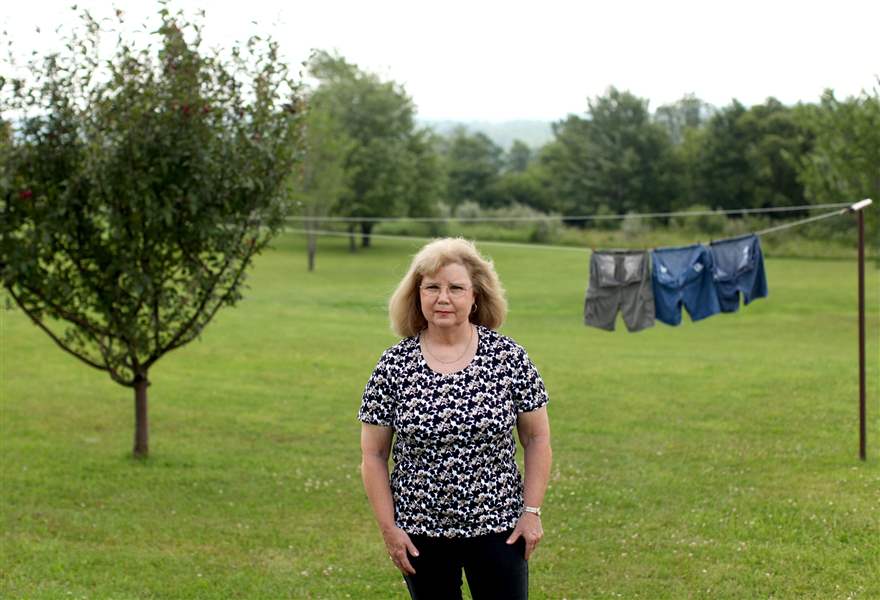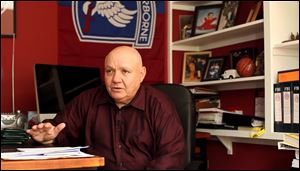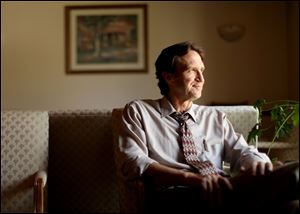
Witness, lawman, coroner look back at tragedy of Flight 93
9/11/2011
Linda Shepley of Stoystown, Pa., was hanging laundry in her yard on the morning of Sept. 11, 2001, when she saw United Airlines Flight 93 pass low overhead. Mrs. Shepley watched as the plane plummeted from view and then saw the fireball of the crash. She and her husband, Jim, then headed for the crash site five minutes away.
Block News Alliance/Andrew Rush

Linda Shepley of Stoystown, Pa., was hanging laundry in her yard on the morning of Sept. 11, 2001, when she saw United Airlines Flight 93 pass low overhead. Mrs. Shepley watched as the plane plummeted from view and then saw the fireball of the crash. She and her husband, Jim, then headed for the crash site five minutes away.
STOYSTOWN, Pa. -- Linda Shepley was taking advantage of the bright September morning, hanging laundry in the yard of her Stoystown home when she heard an airplane approaching. She looked up and saw an incongruous sight: a Boeing 757 coming toward her, much lower than it ought to have been, rolling from side to side as though the pilot was drunk.
She turned to watch the aircraft as it passed overhead, banked to the right, turned upside down, and plummeted nose-first behind the treetops. Seconds later she heard the crash, saw a fireball rise into a mushroom cloud, smelled the acrid scent of burning jet fuel from three miles away.
Unknown to her at the time -- 10:03 a.m. -- her son, Michael, had picked up the visual, catching sight of the plane just as it disappeared from her view. Working at the Rollock Inc. scrap yard on the hill overlooking a reclaimed strip mine, he and a fellow worker had a bird's eye view of the plane falling from the sky and slamming into the field at 563 miles per hour.
Michael Shepley, then 22, not only watched and smelled the catastrophe, he felt the heat from the conflagration and saw debris flying through the air.
As the plane hit, Mrs. Shep-ley screamed to her husband, Jim, to call 911. Then they jumped in the car and peeled off toward the crash site, five minutes away.
Thus the Shepleys, parents and son, were among the first to stand at the smoking grave of United Airlines Flight 93, the only one of four airplanes hijacked by 19 al-Qaeda terrorists that day that did not find its intended target.
The story that soon emerged from flight recorders and other sources riveted the nation.
Flight 93 from Newark, N.J., to San Francisco had been waylaid with the likely intention of slamming it into the White House or the Capitol.
The passengers and crew learned by cell phone of the prior airplane attacks on the World Trade Center and Pentagon, so they staged a revolt. A group rushed the cockpit in an attempt to wrest control of the aircraft. Before they could succeed, the terrorists crashed the plane into the open field.
The flight went down 20 minutes from Washington. There were no survivors. A third of the plane bounced into the trees, the rest plowed deep into the soft earth of the reclaimed strip mine. Excavators hired by the Justice Department dug down 50 feet over the next two weeks and still couldn't find more than a fraction of the human remains. (The black boxes were found at 15 and 25 feet.)
Having foiled an assault on the nation's capital, the men and women aboard that day gained a degree of immortality -- their names are engraved on the walls flanking the path to the crash site at the unfinished Flight 93 National Memorial near Shanksville, Pa.
Every year on the anniversary of the attacks, Mrs. Shep-ley visits the memorial site.
"It's a nice place to reflect and think," she said. "You are so close to the site now, you really feel it. It's a graveyard with no tombstones. We had the same eerie feeling when we visited Gettysburg and the [USS] Arizona in Hawaii. There's a presence."
Seated on the front porch of her rural home on a fine summer day, Mrs. Shepley said she planned to attend this weekend's events marking the 10th anniversary. "I'll be there all day. I want to take in everything I can and talk to anyone who wants to talk."
One reason, she said, is to refute the conspiracy theories that have proliferated over the past decade. That includes contentions that Flight 93 was shot down by a CIA missile.
"I get impatient and frustrated when people say that," Mrs. Shepley said. "If it was shot down, there would have been airplane debris all along its path to the crash site. There wasn't any. The plane was intact until it hit the ground. I know because I saw it.
"It should go into the history books correctly. If the witnesses don't get the truth out, who will?"
With that in mind, Mrs. Shepley and nearly 700 others have made oral history recordings for the Flight 93 memorial's archives. Her son, however, is not one of them.
"He hasn't talked about it in all this time," she said. "I wish he would; I think it would be better for him."
Ten years later, his mother said she remembers those moments as if they were on film inside her head.
"I see it detail for detail," she said. "As the plane flew over it was so close to the ground, I was wondering if they were looking out the window and if they could see me. At that point they must have already charged the cockpit."
She keeps thinking about how close the airplane came to crashing into the scrap yard where her son was working.
"It was a harrowing day," she said, shaking her head. "I have never attempted to fly since 9/11. And when I see any airplane now, I watch till it's out of sight."

Former Pennsylvania State Trooper Bob Weaver arrived at the crash site just after the firefighters. 'I was totally amazed that this big plane was just swallowed up in the ground. … It took a while for it to sink in that there was an airplane in there.'
The state trooper
Lt. Bob Weaver, then 54, was the ranking Pennsylvania state trooper at the crash site on Sept. 11, arriving on the scene just after the firefighters.
"The site was smoldering when we got there," he said. "I was totally amazed that this big plane was just swallowed up in the ground. You could see the silhouette of the fuselage, two lines for the wings, one for the tail. It took a while for it to sink in that there was an airplane in there."
Lieutenant Weaver set up the perimeter to protect the crash site and then went up in a helicopter to see if he could determine how big the debris field was.
"I was amazed there was so little noticeable from the air," he said recently. "Each day we'd get calls about people finding things and we'd expand our perimeter."
Some 300 troopers worked 12-hour shifts for the next month or so, guarding the crime scene while emergency workers, FBI investigators, and others "rolled up their sleeves and went to work."
Lieutenant Weaver retired from the state police in 2004 after 31 years. He said that as horrific as the crash was, he was impressed by all the good that it brought out in people -- the neighbors who delivered a steady stream of food for the state troopers and other workers, the cooperation between agencies that might have clashed under other circumstances, the volunteers who showed up day after day to offer their help.
"Everyone did such a good job, you can't say enough about it. Sometimes being a policeman you don't see a lot of good, but there was so much cooperation and selflessness, it gives you hope."
Every night during the two weeks he worked at the site, he went to a spot behind the mining company where someone had erected a cross and sat on a hay bale to think.
"It was so peaceful and quiet, I would just sit there and reflect," he said.
"Military people are trained to deal with terrorists. These people on Flight 93 took the initiative. You get on a plane for work, you're not a combatant, suddenly you're fighting for your life or someone else's. It's very moving what they did."

Somerset County Coroner Wally Miller became friends with victims' families and still thinks of them that way. 'I never use the word closure with them,' he says. 'You don't get over something like that, you learn how to live around it.'
The coroner
By the time Somerset County Coroner Wally Miller arrived at the crash site, the fires were out and the air was oddly quiet.
"All kinds of small pieces of debris were melting and sizzling like plastic," Mr. Miller recalled. "You could see a gash in the ground, but where was the crash? Then I realized, this was it. The plane hit a reclaimed strip mine so the earth wasn't packed down. A third of it bounced into the trees and the rest went deep into the ground."
Mr. Miller was conversant with tragedy. A Somerset native who ran Miller Funeral Home with his father, he had buried scores of friends and neighbors. But nothing approached the scale of this. Suddenly he was facing the most daunting task of his life.
Surveying the scene, he compared the task ahead with his $68,000 annual budget. All told, the excavation and identification would cost $5 million, with the Justice Department footing the bill.
Mr. Miller set up a temporary morgue in the local armory. Taking up residence were the Disaster Mortuary Operation Response Team, the state police, FBI, Somerset Hospital, Pennsylvania Dental Association's Dental Identification Team, and others. They sorted and catalogued human remains and personal effects, took X-rays, fingerprints, and DNA samples, looked for identifying scars, tattoos, healed fractures, and joint replacements, and compared dental records.
"There were so many federal agencies there, I still have no idea who some of them were or what they did, but I was responsible for all of it," Mr. Miller said.
In the end, search teams recovered only 8 percent of the human remains.
"The other 92 percent got vaporized," Mr. Miller said.
He figures the people on the plane weighed a combined 7,700 pounds, but recovery teams only found 650 pounds, and just under half of those were identifiable.
"We found personal effects for everyone, and at least a little human remains for each person. Everything that was positively identified was returned to the families," he said.
Mr. Miller has been storing three caskets of unidentified material all this time. Finally, at 9:30 a.m. tomorrow, they will be interred at the site during a private funeral service. Mr. Miller will lead the ceremony for family members, park officials, and invited guests.
As the main contact point, Mr. Miller wound up becoming friends with many family members.
"I never use the word closure with them," he said. "You don't get over something like that, you learn how to live around it."
His handling of the disaster earned him wide acclaim and interviews with news outlets from around the world. Everyone was interested in the small-town coroner who rose to the challenge.
"Early on, there were times I thought of things I could've or should've done," he said. "But looking back, I think we handled things as thoroughly as we could. The main thing is that the families said we did."
Ten years later, he said, "I can't feel it now like I could then. It hasn't changed the way I live my life or view myself in the cosmos. I'm still the coroner and a funeral director. The phone rings, there's something I need to do, and I go do it."
Families of Flight 93
As the cousin of Flight 93 victim Louis J. Nacke II, Patrick White said the disaster response people did "an outstanding job under very challenging circumstances. There was extreme emotional duress on the part of family members, but everyone was treated with compassion, sensitivity, and understanding."
Even so, seven weeks after the crash, Mr. Nacke's father, Paul, died -- "of a broken heart," Mr. White said.
"For many years my aunt [Mr. Nacke's mother] wouldn't speak much about any of this," he said. "She had lost her oldest boy and then her husband. But now she's talking about it some and doing much better."
Mr. White is vice president of Families of Flight 93, a nonprofit organization that raises funds to complete the Flight 93 National Memorial, and sits on the memorial's board of directors.
"Working on the memorial and following its progress has given us something to focus our positive energy on and has created some goals and timelines for us to look forward to," he said.
"Our goals over [this weekend] are to be together with the other families, remember the sacrifice of those aboard, and honor it with the dedication of this phase of the memorial.
"None of us will ever be healed. … there will always be some pieces missing."
Block News Alliance consists of The Blade and the Pittsburgh Post-Gazette. Sally Kalson is a staff writer for the Post-Gazette; contact her at: skalson@post-gazette.com or 412-263-1610.